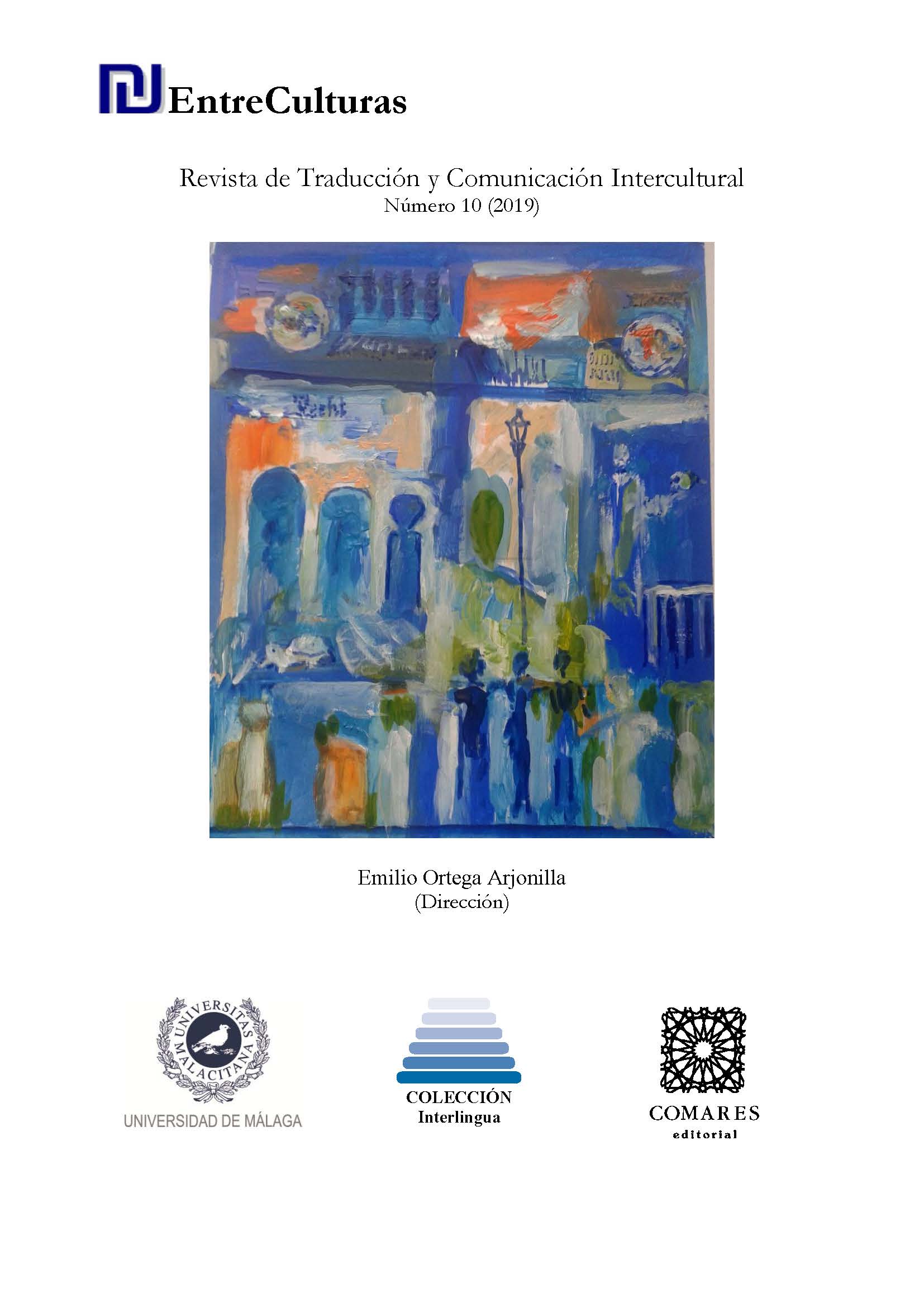The French concept cour des Miracles: ¿patio or corte de los milagros?
DOI:
https://doi.org/10.24310/Entreculturasertci.vi10.12528Keywords:
Etymology, Homonymy, Polysemy, Terminology, TranslationAbstract
This article seeks to explore the origin of the concept cour des Miracles, which was coined in French in the Middle Ages and revived in subsequent centuries by French historians and writers, such as Henri Sauval and Victor Hugo, amongst others. The aim of this research is to analyse the French term cour and its possible equivalences in Spanish, based on etymology and an analysis of the complex homonymic and polysemic connotations that arise from this term both in French and Spanish.
Downloads
Metrics
References
Académie française. Dictionnaire de l´Académie française. [en línea] (2019): https://www.dictionnaire-academie.fr/ [consulta: 30 de abril de 2019].
Académie française. Dictionnaire de l´Académie française. Service du dictionnaire. contact@academie-française.fr [consulta: 1 de mayo de 2019].
Bosque, I. & Muñoz, I. B. (Eds.). (2004). Redes: diccionario combinatorio del español contemporáneo. Madrid: Ediciones SM.
Casares, J. (1959). Diccionario ideológico de la lengua española. Barcelona: Gustavo Gili.
Centre National de Ressources Textuelles et Lexicales (CNRTL) [en línea] (2012): https://www.cnrtl.fr [consulta: 17 de mayo de 2019].
Diccionario de uso del español actual CLAVE. [en línea] (2014): http://clave.smdiccionarios.com/app.php Madrid: Ediciones SM.
Dictionnaire des expressions et locutions (DEL). París: Dictionnaires Le Robert, 2007.
Dictionnaire historique de la langue française (DHLF). París: Dictionnaires Le Robert, 1995.
Doré, G. (1859). La cour des Miracles. http://parismuseescollections.paris.fr/fr/maison-de-victor-hugo/oeuvres/la-cour-des-miracles#infos-principales [consulta: 25 de mayo de 2019].
Encyclopaedia Universalis [en línea] (2019): https://www.universalis.fr/ [consulta: 17 de mayo de 2019]. Grand dictionnaire français-espagnol / espagnol-français - Gran diccionario francés-español / español-francés. París: Larousse, 1992.
Hugo, V. Notre-Dame de Paris (1831). Editorial del grupo «Ebooks libres et gratuits». Publicado el 16 de enero de 2006. https://www.ebooksgratuits.com/html/hugo_notre_dame_de_paris.html [consulta: 29 de abril de 2019].
Hugo, V. La Esmeralda (Nuestra Señora de París), versión española por Francisco Nacente. Barcelona: Biblioteca escogida de Juan Aleu, editor, 1875. Biblioteca Digital Hispánica.
http://bdh-rd.bne.es/viewer.vm?id=0000137269&page=1 [consulta: 30 de abril de 2019].
Hugo, V. Nuestra señora de París, traducción de D. Manuel Saurí y de D. José Tauló, edición en 2 tomos. Barcelona: Imprenta de J. Tauló, 1841.
Hugo, V. Nuestra señora de París, traducida de la última edición francesa por D. Eduardo Fernández. Madrid: Gaspar y Roig, 1846.
Hugo, V. Nuestra señora de París. Edición en dos tomos. México: Imprenta de Ignacio Cumplido, 1856.
Hugo, V. Los Miserables, Nuestra Señora de París, El Noventa y Tres. Novela Ilustrada. Madrid: Imprenta de A. Marzo, primera mitad del siglo XX.
Le Petit Robert. París: Editorial Dictionnaires Le Robert, 2012.
Le Trésor de la Langue Française informatisé (TLFi) issu du Trésor de la Langue Française (1971-1994). ATILF - CNRS & Université de Lorraine. [en línea] (1994): http://atilf.atilf.fr/ [consulta: 17 de mayo de 2019].
Larousse de la langue française lexis. París: Librairie Larousse, 1979.
Moliner, M. (1998). Diccionario de uso del español (DUE). Madrid: Gredos.
Real Academia Española. Corpus Diacrónico del Español (CORDE) [en línea] (1994): http://corpus.rae.es/cordenet.html [consulta: 12 de mayo de 2019].
Real Academia Española. Diccionario de la lengua española (DLE) [en línea] (2014): https://dle.rae.es/ [consulta: 12 de mayo de 2019].
Real Academia Española. Nuevo diccionario histórico del español (NDHE) [en línea] (2013): http://web.frl.es/DH/ [consulta: 12 de mayo de 2019].
Real Academia Española. Nuevo tesoro lexicográfico de la lengua española (NTLLE) [en línea] (2001): http://ntlle.rae.es/ntlle/SrvltGUILoginNtlle [consulta: 12 de mayo de 2019].
Sauval, H. (1733). Histoire et recherches des Antiquités de la ville de Paris, 3 volúmenes. http://th3.fr/imagesThemes/docs/ENSAPB_2014_cours_des_miracles_R7.pdf?PHPSESSID=fvtkroupr85hv7al26dvbf2a85 [consulta: 20 de mayo de 2019].
Downloads
Published
How to Cite
Issue
Section
License
All contents published in Entre culturas. Revista de traducción y comunicación intercultural are protected under the Creative Commons Attribution-NonCommercial-ShareAlike 4.0 International (CC BY-NC-SA 4.0) license. All about this license is available in the following link: <http://creativecommons.org/licenses/by-nc-sa/4.0>
Users can copy, use, redistribute, share and exhibit publicly as long as:
- The original source and authorship of the material are cited (Journal, Publisher and URL of the work).
- It is not used for comercial purposes.
- The existence of the license and its especifications are mentioned.
There are two sets of authors’ rights: moral and property rights. Moral rights are perpetual prerogatives, unrenounceable, not-transferable, unalienable, imprescriptible and inembargable. According to authors’ rights legislation, Entreculturas. Revista de traducción y comunicación intercultural recognizes and respects authors moral rights, as well as the ownership of property rights, which will be transferred to University of Malaga in open access. The property rights are referred to the benefits that are gained by the use or the dissemination of works. Entreculturas. Revista de traducción y comunicación intercultural is published in an open access form and it is exclusively licenced by any means for doing or authorising distribution, dissemination, reproduction, , adaptation, translation or arrangement of works.
Authors are responsable for obtaining the necessary permission to use copyrighted images.





7.png)
